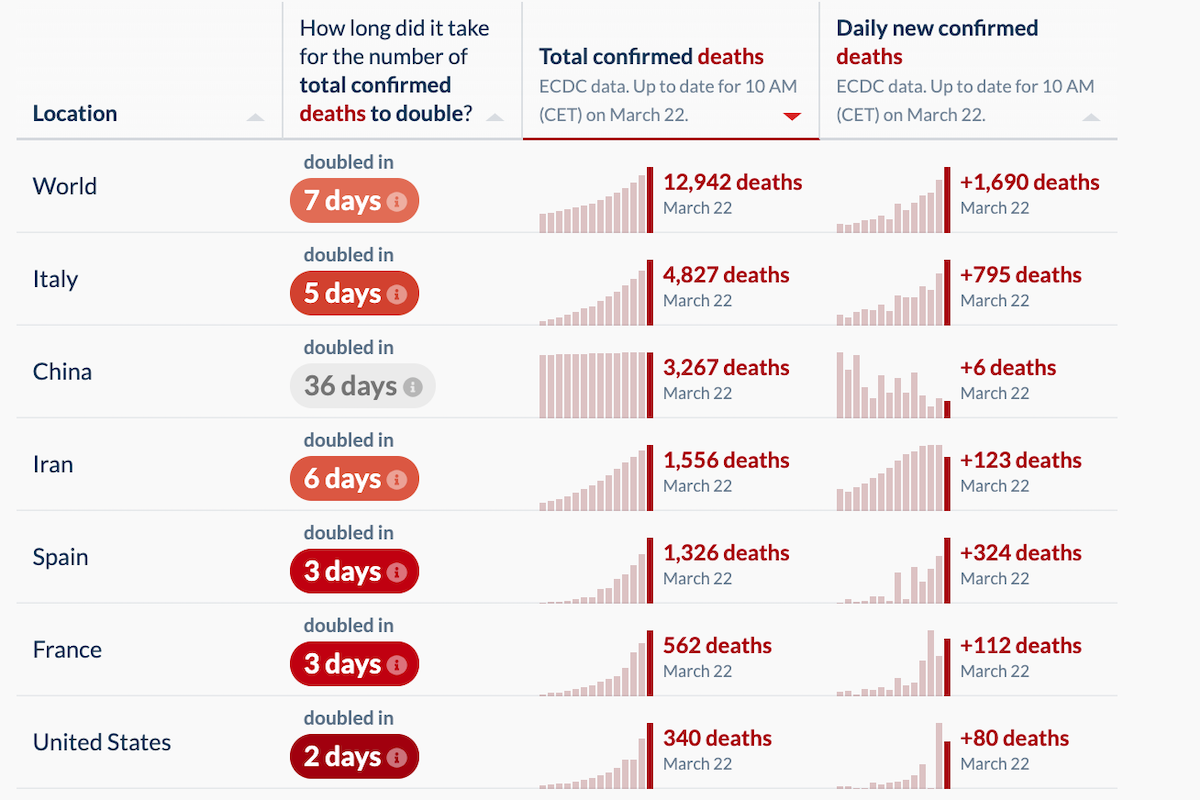COVID-19 Updates
COVID-19 Science Update for March 23rd: The Wealth Paradox
For the first time in a week, the daily number of new global confirmed COVID-19 deaths has dropped—from 1,690 to 1,660. That’s a small drop, but it’s important.

The latest global data for COVID-19—updated with reports received on March 23rd, 2020—have been published at Our World in Data. Here are some of the numbers and trends that I believe deserve special attention, as well as a brief report on notable regional developments and media analyses. Since March 21st, these updates have been published at Quillette in our section marked COVID-19 UPDATES. Please report needed corrections or suggestions to [email protected].
Let me start off with some good news: For the first time in a week, the daily number of new global confirmed COVID-19 deaths has dropped—from 1,690 to 1,660. That’s a small drop, but it’s important. Since I began doing these updates informally on my Facebook page, there has always been at least one country, every day, that has reported a horrifying surge in daily death rates. (The last time that the daily death rate dropped was March 16th — 17th, and even that seemed to have resulted from the previous day’s anomalous doubling of global daily fatalities, fed by an order-of-magnitude increase in Spain, from 15 to 152 in one day.) The rate of daily new cases also fell, from roughly 34,000 to roughly 33,000.
In Italy, which has accounted for about half of all fatalities over the last week, the latest daily tally of new deaths was 649. That’s awful, but it actually represents a significant reduction from the previous day’s total of 795. There is a widely shared photo of Italian military vehicles lined up outside of a hospital, helping with the disposal of victims’ corpses, which is the sort of image we associate with apocalypse movies. The extraordinarily high apparent COVID-19 death rate in Italy will be studied by health professionals for years.
Spain had 394 deaths, an alarming number, and its fourth straight day of significant upward acceleration. Spain’s apparent case-fatality rate is six percent, less than Italy’s 9.25 percent, but still extraordinarily high (though I again offer the caveat that since testing protocols vary widely from one country to the next, none of this data is scientifically precise). And there are an enormous number of infected health workers, which doesn’t bode well for short-term medical success. These two countries—Italy and Spain—now account for more than half of all COVID-19 deaths.
In other countries with relatively high total deaths, the numbers suggest a possible plateau. France had 112 new deaths, which is about its average for the last four days. Iran had 129, which is about average for its last 10 days. The UK had 48, about average for the last five-day period. The United States had 131 more deaths, which is a new daily high, but perhaps only a grim taste of things to come, given some of the bad omens I discussed yesterday.
To understand how uniquely deadly this pandemic has become in Italy and Spain, I looked at nationally reported case fatality rates for countries with more than 500 confirmed cases—plus a few other countries that came close to this benchmark, but which are in roughly the same geographic region.

What you find is that most OECD countries are below 2 percent, or at least close to that figure. For instance: Australia 0.4 percent, Austria 0.4 percent, Belgium 2.2 percent, Canada 1.3 percent, Croatia 0.4 percent, Denmark 0.9 percent, Germany 0.4 percent, Greece 2.4 percent, Norway 0.3 percent, Poland 1.1 percent, Slovenia 0.2 percent, Serbia 0.5 percent, Sweden 1.1 percent, Switzerland 0.9 percent, Portugal 0.9 percent. Worrying outliers include France at 4.2 percent, the Netherlands at 4.3 percent, and the UK at 4.9 percent.
Internationally, you have Indonesia at 9.3 percent, Iran at 7.8 percent, and Iraq at 8.6 percent—though, of those three, only in Iran is the scale of the reported numbers comparable to most European nations. You also have the Pacific Rim countries that suffered their outbreaks early (China 4 percent, Japan 3.8 percent, South Korea 1.3 percent), but in all those cases, the latter-period case fatality rates were brought down well below one percent as testing became more widespread.
As others have pointed out, these viral pandemics often are highly sensitive to climate and geography—which is why I looked at places neighbouring northern Italy, where the Italian cases are clustered. You just don’t see anything comparable in, say, Austria, Croatia, or the Balkans more generally. In France, you see a disproportionate number of cases in the more populous eastern part of the country, but nothing comparable to the dense clustering in Italy’s north-western Lombardy region. In Spain, a disproportionate number of cases are clustered in the southern regions, but the problem is national in scope.
There are at least two other places worth noting here. One is the microstate of San Marino, which sits on the eastern side of the Italian peninsula, roughly east of Florence. Though its population is only 33,000, it has reported 151 cases—about 1/200th of the population—of which 20 have died. This marks a death rate of 13.25 percent, the highest in the world to my knowledge (though some indices presumably lump San Marino in with Italy, and it may be the case that some severe Italian cases are being diverted to San Marino). Canada, which is almost exactly 1,000 times more populous, has just 18 total deaths. And while San Marino is landlocked within Italy, it operates its own universal and highly acclaimed health system.
This gets to one of the stunning ironies regarding the current pandemic. Go down the WHO’s list of the world’s best health systems, and here’s what you find, in descending order from the very top: (1) France, (2) Italy, (3) San Marino, (4) Andorra, (5) Malta, (6) Singapore, (7) Spain. Neither Malta nor Andorra, both with tiny populations, report any deaths. But all of the other places here are either being ravaged by COVID-19; or, in the case of Singapore, stopped a large, early outbreak through unusually aggressive measures. Meanwhile, countries such as Canada, Denmark, and Israel, which are all well down on that WHO list, seem to be managing their outbreaks—if not yet completely suppressing them.
One more country to focus on is Turkey. According to official data, the country didn’t report its first case until March 12th. But it already has 300 new cases per day, and 30 total deaths. Geographically and climatologically, it has plenty of regions that are comparable to those in Italy, Spain, and Iran. And unlike those countries, it also has a huge refugee population that will be difficult to medicate or even control if an outbreak takes place on a large scale. Overall, today’s global COVID-19 news offered a basis for guarded hope. But it’s inevitable that many more countries, possibly including Turkey, will continue to suffer terrible outbreaks.






